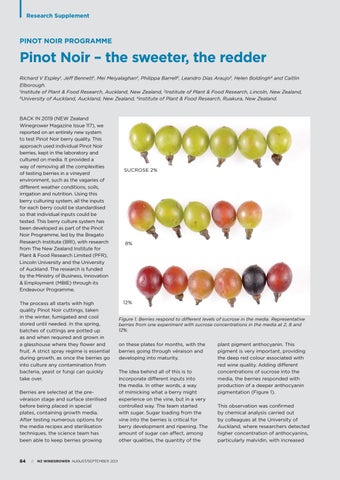Research Supplement
PINOT NOIR PROGRAMME
Pinot Noir – the sweeter, the redder Richard V Espley1, Jeff Bennett1, Mei Meiyalaghan2, Philippa Barrell2, Leandro Dias Araujo3, Helen Boldingh4 and Caitlin Elborough. 1 Institute of Plant & Food Research, Auckland, New Zealand, 2Institute of Plant & Food Research, Lincoln, New Zealand, 3 University of Auckland, Auckland, New Zealand, 4Institute of Plant & Food Research, Ruakura, New Zealand.
BACK IN 2019 (NEW Zealand Winegrower Magazine Issue 117), we reported on an entirely new system to test Pinot Noir berry quality. This approach used individual Pinot Noir berries, kept in the laboratory and cultured on media. It provided a way of removing all the complexities of testing berries in a vineyard environment, such as the vagaries of different weather conditions, soils, irrigation and nutrition. Using this berry culturing system, all the inputs for each berry could be standardised so that individual inputs could be tested. This berry culture system has been developed as part of the Pinot Noir Programme, led by the Bragato Research Institute (BRI), with research from The New Zealand Institute for Plant & Food Research Limited (PFR), Lincoln University and the University of Auckland. The research is funded by the Ministry of Business, Innovation & Employment (MBIE) through its Endeavour Programme. The process all starts with high quality Pinot Noir cuttings, taken in the winter, fumigated and cool stored until needed. In the spring, batches of cuttings are potted up as and when required and grown in a glasshouse where they flower and fruit. A strict spray regime is essential during growth, as once the berries go into culture any contamination from bacteria, yeast or fungi can quickly take over. Berries are selected at the prevéraison stage and surface sterilised before being placed in special plates, containing growth media. After testing numerous options for the media recipes and sterilisation techniques, the science team has been able to keep berries growing
84 //
NZ WINEGROWER AUGUST/SEPTEMBER 2021
SUCROSE 2%
8%
12% Figure 1. Berries respond to different levels of sucrose in the media. Representative berries from one experiment with sucrose concentrations in the media at 2, 8 and 12%.
on these plates for months, with the berries going through véraison and developing into maturity. The idea behind all of this is to incorporate different inputs into the media. In other words, a way of mimicking what a berry might experience on the vine, but in a very controlled way. The team started with sugar. Sugar loading from the vine into the berries is critical for berry development and ripening. The amount of sugar can affect, among other qualities, the quantity of the
plant pigment anthocyanin. This pigment is very important, providing the deep red colour associated with red wine quality. Adding different concentrations of sucrose into the media, the berries responded with production of a deeper anthocyanin pigmentation (Figure 1). This observation was confirmed by chemical analysis carried out by colleagues at the University of Auckland, where researchers detected higher concentration of anthocyanins, particularly malvidin, with increased
